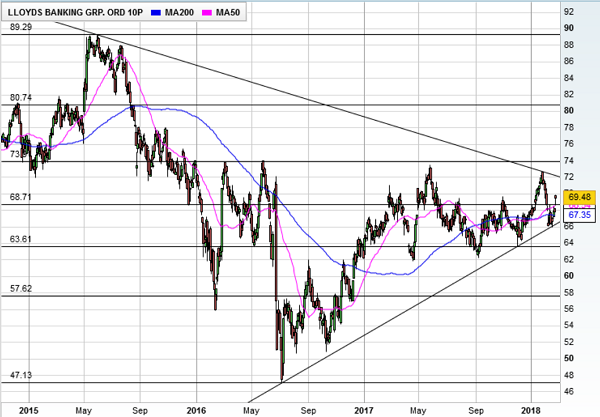Why Lloyds Bank is a 'core portfolio essential'
21st February 2018 12:43
That is strong enough to commit to a £1 billion share buy-back just six months after returning to private ownership is an impressive landmark in the rejuvenation of this financial institution.
Today's show of strength from Antonio Horta-Osorio was taken positively by markets, with shares up 2% even though full-year profits of £5.3 billion came in short of expectations due to a further PPI provision.
Analysts also welcomed the CEO's long-awaited strategy update for the next three years, particularly in light of his renewed focus on digital banking and a pledge to keep operating costs to below £8 billion in 2020.
Other key metrics in the annual results were positive, not least the increase in net interest margin to 2.86% and vow to keep it at this level in 2018.
But the results were still tinged with frustration for some of Lloyds' army of small shareholders, who have largely seen shares stuck in the slow lane despite brightening prospects and an improving dividend yield.
Their discontent, expressed on interactive investor discussion forums today, focused on the return of capital through a 1.4p a share buy-back rather than a special dividend, as was the case last year.
When including this one-off award of 0.5p in 2016, shareholders point out that today's total dividend of 3.05p is unchanged on last year.
Lloyds says that buy-backs offer increased flexibility, particularly as it moves towards normalising ordinary dividend payments. After all, if a special dividend is paid every year it can no longer be considered 'special'.
The bank adds that the share buyback of up to £1 billion increased capital returns by up to 46% to as much as £3.2 billion in the financial year.
Credit Suisse said recently it believes there's scope for as much as £15 billion to be returned to Lloyds shareholders by the end of 2020, including today's award.
Strong capital generation appears to support this view, with Lloyds' CET1 capital ratio up to 15.5% prior to today's dividend and buy-back. This compares with 14.1% a year earlier and 13.9% once capital returns are included.

UBS analyst Jason Napier expects a "steady stream of buy-backs" to follow, resulting in an 8% yield.
He said:"Plans to grow revenues at stable margins, cut costs and generate surplus capital should reassure investor concerns we think, delivering PBT upgrades and EPS momentum."
Napier said Lloyds was attractively valued at 8.8 times projected 2018 earnings per share (EPS).
Richard Hunter, head of markets at interactive investor, believes that today's results were a signal of a return to the halcyon days of Lloyds being "an investor's core portfolio essential, given the generous and stable dividend".
One nagging issue for Lloyds remains PPI, which required an additional provision of £600 million in the fourth quarter to reflect an increase in expected weekly complaints from 9,000 to 11,000. This was £300 million ahead of consensus and contributed to today's profits miss.
Lloyds estimates that it sold approximately 16 million PPI policies from 2000 and that it has contacted, settled or provided for approximately 53% of them. This latest provision reflects increased complaint levels, including the impact of the first FCA advertising campaign before the August 2019 industry deadline.
The PPI blow came alongside an uptick in impairments, which rose by 23% to £795 million in 2017. The prospect of rising interest rates means that this will have to be closely watched, particularly in the recently acquired credit card business.
These articles are provided for information purposes only. Occasionally, an opinion about whether to buy or sell a specific investment may be provided by third parties. The content is not intended to be a personal recommendation to buy or sell any financial instrument or product, or to adopt any investment strategy as it is not provided based on an assessment of your investing knowledge and experience, your financial situation or your investment objectives. The value of your investments, and the income derived from them, may go down as well as up. You may not get back all the money that you invest. The investments referred to in this article may not be suitable for all investors, and if in doubt, an investor should seek advice from a qualified investment adviser.
Full performance can be found on the company or index summary page on the interactive investor website. Simply click on the company's or index name highlighted in the article.
Editor's Picks